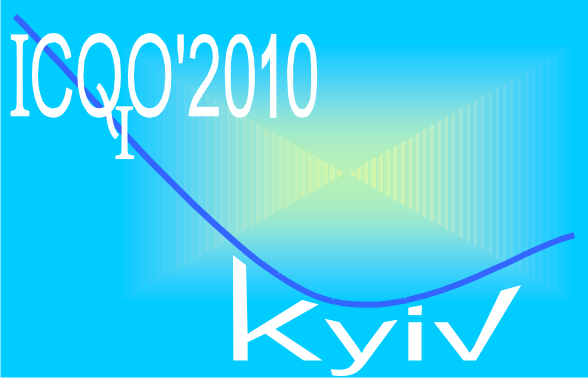 |
XIII International Conference on Quantum Optics and Quantum Information May 28–June 1, 2010, Kyiv, UKRAINE |
|||
• Announcement • Conference Programme • Registration • Important dates • Committees • Hotel accommodation • Visa support • Conference place • How it was • History of ICQOQI • SQO-I • SQO-II • SQO-III • SQO-IV • SQO-V • SQO-VI • SQO-VII • SQO-VIII • ICQO-IX • ICQO-X • ICQO-XI • ICQIO-XII [an error occurred while processing the directive] |
The third All-Union Seminar on Quantum Optics (SQO-III) was held in Raubichi from May 15 to 18, 1990. Clear definition of new problems and paradoxes of quantum optics was its distinctive feature. These are: ( I ) quantum electrodynamics of processes in cavities, (2) macroscopic quantum fluctuations (solitons and solitonlike noise spikes), and (3) the "paradox" of negative feedback. (1) The fact that spontaneous emission of atoms can be modified by varying the spectral density of electro-magnetic waves with which an atom interacts was realized, and experimental capabilities for the study of interaction of a single atom with a single mode of electromagnetic radiation in the microwave and optical ranges were developed. Because of this, quantum-optical problems of interactions of atoms with an intracavity field developed into an independent group of problems. In the report by S.Ya. Kilin and T.B. Krinitskaya devoted to these problems, a new effect - phase bistability of emission of a single atom in a high-finesse optical cavity was reported. S.N. Andrianov (Kazan Engineering Physics Institute, KEPI) presented results of a study of cooperative quantum effects in cavities. (2) The quantum theory of optical solitons was presented in the report by A.S. Chirkin. The problem of macroscopic quantum noise of SRS intensity and the statistics of solitonlike optical pulses appearing in this case was the subject of reports by A.I. Sokolovskaya (FIAN), S.Ya. Kilin and I.I. Fedchenya, PA. Apanasevich, V.A. Orlovich, A.S. Grabchikov, V.P. Kozich, and D.E. Gakhovich (IP BAS). (3) The discussion of the paradox of negative feedback turned out to be rather lively and fruitful, as subsequent years showed. This included the observation of sub-Poissonian statistics of photoelectrons in a detector connected in the feedback circuit, super-Poissonian statistics in a detector outside of this circuit, and the problems of states of light inside the feedback circuit. This problem, initiated by experiments by Yamamoto and Fofanov, was discussed in reports by Ya.A. Fofanov (IAP), A.S. Troshin (LSPI), and L.I. Plimak (LSU). A number of reports on the "squeezed states of optical fields" problem was presented at SQO-III. Classical and quantum effects in two-photon squeezed light were considered in the report by D.N. Klyshko (MSU). A.V. Vinogradov and I. Jansky (FIAN) reported a new method for representing squeezed states in the form of a superposition of coherent states along a line. The problem of detecting multimode squeezed light was discussed in detail by A.V. Masalov (FIAN). The results of an experimental study of squeezed states of the radiation field of a picosecond parametric optical oscillator were presented by A. Stabinis (Kyiv University). Nonclassical effects in the anharmonic oscillator model were considered by R. Tanas' (UINR, A. Mitskevich University, Poznan'). S.M. Arakelyan (Erevan State University, ESU) talked about the transformation of squeezed states in the case of scattering in periodic media. A number of reports were devoted to the problem of space-time structure of multimode squeezed states (M.I. Kolobov and I.V. Sokolov, LSU) and the Einstein-Podolsky-Rosen paradox associated with it (A.N. Penin and A.S. Sergienko, MSU). The reports by V.N. Gorbachev (LSU), I.V. Sokolov (LSU), A.M. Basharov (Moscow Engineering Physics Institute, MEPI), and B.G. Sherman (Institute of Physical Research, Academy of Sciences of Armenia) were devoted to the problems of application of squeezed states of light and their interaction with a substance. The ideas advanced in the reports by Yu.M. Golubev (LSU), "Light Source with a Strictly Regular Flow of Photons," and A.V. Belinskii (MSU), "The Formation of Sub-Poissonian Fields in Nonlinear Systems with Saturation," are still topical. Results on nonlinear subharmonics in the polarization spectrum (S.A. Purkin, VNIM), the structure of the superfluorescence spectrum [B.M. Chernobrod (Institute of Atomic Energy, Siberian Division of the Academy of Sciences of the USSR, IAE SD AS USSR)], self-localization of an atomic ensemble in an optical field [V. P. Yakovlev (MEM) and tile measurement of the topological phase in a two-level system (V.N. Lisin (KEPI)) were presented in the section "Coherent Phenomena of Quantum Optics." Memory effects of relaxation as applied to transient coherent optical phenomena (PA. Apanasevich, S.Ya. Kilin, A.P Nizovtsev, and N.S. Onishchenko (IPBAS), V.S. Malinovskii Institute of Thermal Physics, Siberian Division of the Academy of Sciences of the USSR, (ITP SD AS USSR), and R.N. Shakhmuratov (KEPI)) and special features of relaxation in three-level systems (D.Yu. Kuznetsov (FIAN)) were discussed in the section "Modification of Relaxation in Strong Laser Fields." T.K. Melik-Barkhudarov (ESU) reviewed the utilizations of the method of path integrals in quantum optics. A number of reports presented at SQO-III were published in Optika i Spektroskopiya (Optics and Spectroscopy), 1991, vol. 70, no. 3. |
|||
|
||||